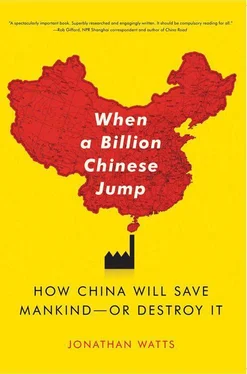86. Rice production is actually far worse for the swampland than corn or wheat because huge amounts of water must be pumped, channeled, and otherwise diverted to flood the fields.
87. Migration accelerates this trend. Old residents of formerly wild areas know what has been lost and often support a limited degree of conservation, but the influx of newcomers means most of the population have no memory of the ecological past. They compare Heilongjiang to the degraded cities and farmlands they left behind and see a land ripe for exploitation. Migrants also tend to be poorer and in a greater hurry to make money. Without a belief in sustainability and no sense of ownership or responsibility, they tear into the black soil, the wetlands, and the forest (Pickles, “Implementing Ecologically Sustainable Development in China”).
88. Heilongjiang became the first province in China to move 100 percent to this form of fuel in 2008. The three northeast provinces of Heilongjiang, Jilin, and Liaoning were among the first to use ethanol. The government estimated that, nationwide, half of the fuel sold for cars would be ethanol by 2010 (Xinhua, “China Enlarges Bio-Ethanol Fuel Coverage,” April 1, 2008).
89. Remote-sensing surveys show that China’s cultivated land area plummeted between 1988 and 2000, from 1,307,400 square kilometers in 1991 to 1,282,400 square kilometers in 2000—or from 1.8 mu (0.0012 square kilometer) per head to 1.5 mu (0.0010 square kilometer) per head. Construction accounted for 56.6 percent of the decrease, 21 percent of land was forested, 16 percent was flooded, and 4 percent became grassland. Jasper Becker says the shortage of land is used by the government as an excuse for wasteful agricultural practices. “China feeds 20 percent of the world’s population on seven percent of the planet’s arable land. This fact is often cited by government leaders to excuse rural poverty and the widespread use of chemicals to squeeze more value out of the land. But Japan and South Korea have far higher population densities relative to arable land, yet their economies are considerably stronger and greener than China’s” (Becker, Hungry Ghosts, p. 262). The former water minister Qian Zhengying has advised Premier Wen to increase food production still further in the area to replace the degraded lands of the northwest.
90. Ma is now going back to the drawing board to try to find a compromise that will allow the area to develop, while minimizing the ecological impact. He is shifting his focus from the top level of government to the local people and local governments—that middle band of China where power now lies. Ironically, to win them over, he once again finds himself advocating the conversion of wetlands to dry field production. It is another turning point, back toward the activity he was doing as a fifteen-year-old pioneer. It is the lesser of two evils. What he helped to do during the Cultural Revolution had a bad impact, but not as bad as what is being done now.
1. He was so impressed with the Taoist monk Qiu Chuji that, after sacking Beijing, he reconstructed the White Cloud Temple in the city in his honor.
2. Scott Mills, Conservation of Wildlife Populations (Blackwell, 2007), p. 14.
3. Presentation by Nicholas Stern, former chief economist at the World Bank, based on estimates of CO 2emissions from energy consumption and cement production using data from the China National Bureau of Statistics, IPCC, the World Bank, and Oak Ridge National Laboratory.
4. See ch. 12.
5. Three aerosol clouds struck Beijing during spring and early summer 2008, dashing hopes that the “Great Green Wall” of poplars and other trees (see ch. 15) might protect the Chinese capital before the Olympics. NASA satellite images showed the worst of them, on March 1, completely obscuring a 150,000-square-kilometer area of land stretching from Beijing down to Xian and halfway across the Bohai Sea. The following day, it hit South Korea, where several schools were closed amid health fears. A day later, Japanese newspapers were warning the year’s first kosa (yellow sand) had arrived in Okinawa and was heading northeast toward Tokyo, obscuring the sky as it traversed the archipelago. It then made its way toward the Pacific and the western coast of the United States, where millions of tons of dust and other airborne pollutants from China are deposited each year. By one estimate, half the airborne dust in the world comes from China (L. Ochirkhuyag and R. Tsolmon, “Monitoring the Source of Transnational Dust Storms in Northeast Asia,” International Archives of the Photogrammetry, Remote Sensing and Spatial Information Sciences 37 [2008], Beijing).
6. China has eight distinct gravel desert zones to which the Mongol gobi is applied, and four sandy desert zones designated by the Chinese shadi or shamo. (In gobi the dunes are more mobile.) The eight gobi regions account for about 42 percent of China’s total desert areas (Dee Mack Williams, Beyond Great Walls: Environment, Identity, and Development on the Chinese Grasslands of Inner Mongolia [Stanford University Press, 2002]).
7. Ibid.
8. Lester Brown, The Earth Policy Reader (Norton, 2002), p. 31.
9. Ibid., pp. 28–31, and personal interview.
10. Cited in Richard B. Harris, Wildlife Conservation in China: Preserving the Habitat of China’s Wild West (East Gate, 2008), p. 38.
11. Though the extent of the degradation is difficult to assess, because there is no quantifiable definition of “degradation” and hence no accurate statistics.
12. Kerry Brown cites Chinese government figures showing that between 1967 and 1969, 16,222 people died and over 340,000 suffered physical injury during the purge of an alleged Mongolian independence party that later communist leaders admitted had never existed (Kerry Brown, The Purge of the Inner Mongolian People’s Party in the Chinese Cultural Revolution, 1967–69: A Function of Language, Power and Violence [Global Oriental, 2006]). Judith Shapiro notes that the amount of land cleared in Inner Mongolia was about a twentieth of that in Heilongjiang and a fortieth of that in Xinjiang (Judith Shapiro, Mao’s War Against Nature [Cambridge University Press, 2001], p. 40).
13. Interview with John MacKinnon, head of the EU-China Biodiversity Programme.
14. By a quirky coincidence, the rodent control headquarters is located next to China’s Wildlife Conservation Society.
15. According to Chen, a team of botanists discovered 697 species of plants on the grasslands during a survey in 2005.
16. Speaking more broadly on the entire western and northern grasslands, Harris observes, “It is safe to conclude that many western Chinese rangelands no longer produce the abundance of palatable vegetation they formerly did, have lost soil matter or productivity, and are less efficient at facilitating quick weight gains in domestic livestock” (Harris, Wildlife Conservation in China, p. 38).
17. This was seen as a factor in the 2008 milk-contamination scandal. Wholesalers added melamine to watered-down milk to make the protein levels look higher during inspections. At least six infants died after drinking the contaminated milk.
18. See ch. 15, n. 24.
19. South Korea’s largest environmental NGO was given funds by the government in Seoul to try to reduce the degradation of the grasslands because the resulting sandstorms are a major problem on the peninsula.
20. According to Dai Qing, on her advice.
21. Among the other leading groups are Global Village of Beijing, whose founder Liao Xiaoyi won the Norwegian Sophie Prize in 2000, and Green Watershed, led by Yu Xiaogang, who won the Goldman Environmental Prize in 2006, the same year that the environmentalist Ma Jun, author of China’s Water Crisis and founder of another green NGO, the Institute of Public and Environmental Affairs, was named by Time as one of 100 people who shape our world (Nick Young, “International Fillip for Chinese Greens,” China Briefing, May 6, 2006).
Читать дальше










